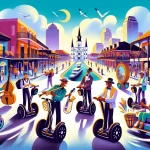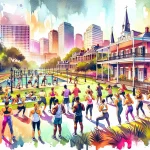The Downtown Irish Club St. Patrick’s Day Parade weaves the vibrant spirit of New Orleans with the treasured traditions of Ireland. This annual celebration is more than just a parade; it’s a testament to the city’s ability to harmoniously blend diverse cultures into an unforgettable experience.
In This Article
TL;DR
- The parade honors Irish heritage while embracing New Orleans’ cultural diversity.
- Colorful floats, traditional Irish music, and dance performances enliven the route through iconic city locations.
- Participants and spectators can secure prime viewing spots, join the festivities, or explore related events and attractions.
Historical Context and Significance
The Origins of the Downtown Irish Club
Founded in 1976 by Roy Markey Sr. and Edward “Bud Rip” Ripoll Jr., the Downtown Irish Club was established to preserve and perpetuate Irish identity in New Orleans. The club’s diverse membership reflects the idea that “everyone is Irish for a day.” The club’s founders were influential figures in the Bywater neighborhood, and their iconic establishments served as the starting point for the annual St. Patrick’s Day parade.
Evolution of the St. Patrick’s Day Parade
Over the years, the Downtown Irish Club St. Patrick’s Day Parade has blossomed into a beloved New Orleans tradition. It stands as the only parade that takes place on St. Patrick’s Day proper, with stops at iconic locations like Frenchmen Street, Decatur Street, and Tchoupitoulas Street. The parade has become a showcase of Irish heritage interwoven with New Orleans’ unique cultural fabric.
Parade Highlights
Route and Key Locations
The parade commences at Washington Square Park in the Marigny neighborhood and winds its way through the French Quarter and CBD. The route is adorned with historic landmarks and sites, such as the French Market, Jackson Square, and the Hibernia Bank Building. These locations add to the parade’s charm and significance.
Notable Floats and Groups
The Downtown Irish Club St. Patrick’s Day Parade features a variety of floats, marching groups, and bands. Some of the most anticipated entries include the club’s own float, adorned with shamrocks and Irish flags, and the Muggivan School of Irish Dance, which performs traditional Irish dances along the route.
Music and Performances
Music is an integral part of the parade, with traditional Irish tunes intertwining with the sounds of New Orleans jazz and brass bands. Local favorites like the Storyville Stompers Brass Band and the Panorama Jazz Band have become staples of the event, adding to the festive atmosphere.
Participation and Experience
Viewing the Parade
To get the best view of the parade, arrive early and secure a spot along the route. Some of the most popular viewing areas include the intersection of Frenchmen and Decatur Streets, the neutral ground on Tchoupitoulas Street, and the steps of the Hibernia Bank Building. Be sure to bring chairs, snacks, and drinks to make the most of your parade experience.
Joining the Festivities
Individuals and groups can participate in the parade by joining the Downtown Irish Club or by creating their own marching group or float. The club welcomes new members at their general meetings throughout the year. To enter a float or marching group, contact the club for registration requirements and fees.
Community Impact
Economic Benefits
The Downtown Irish Club St. Patrick’s Day Parade has a significant impact on local businesses, particularly bars, restaurants, and hotels in the French Quarter and CBD. The influx of visitors during the parade weekend provides a boost to the local economy and helps promote tourism in New Orleans.
Cultural Contributions
The parade fosters a sense of community and celebrates Irish heritage within New Orleans. It has become an integral part of the city’s cultural landscape, influencing local traditions and annual events. The parade’s success has inspired the creation of similar events, such as the Irish Channel St. Patrick’s Day Parade and the Metairie Road St. Patrick’s Day Parade.
Safety and Regulations
Safety Tips for Attendees
To stay safe during the parade, be aware of your surroundings and stick with your group. Keep an eye on your belongings, especially in crowded areas. If you need assistance, look for parade marshals or local law enforcement officers along the route. First aid stations are typically set up at key locations in case of emergencies.
Parade Regulations and Etiquette
Parade participants and spectators are expected to follow certain rules and guidelines to ensure a safe and enjoyable experience for everyone. These include:
- No glass containers or open containers of alcohol outside of designated areas
- No throwing objects from floats or balconies
- Respect private property and do not litter
- Follow the instructions of parade marshals and law enforcement officers
Planning Your Parade Experience
Best Times and Locations
To make the most of your Downtown Irish Club St. Patrick’s Day Parade experience, plan to arrive early and secure a spot along the route. The parade typically starts at 6:00 PM on St. Patrick’s Day, but crowds begin gathering in the early afternoon. Consider exploring other related events happening around the parade, such as block parties on Frenchmen Street or live music at local pubs.
Accommodations and Dining
If you’re looking for accommodations near the parade route, consider staying at one of the many hotels in the French Quarter or CBD. Some popular options include the Monteleone Hotel, the Royal Sonesta, and the Omni Royal Orleans. For dining, check out local Irish pubs like Erin Rose, The Irish House, or Finn McCool’s Irish Pub for authentic Irish fare and festive atmospheres.
The Downtown Irish Club St. Patrick’s Day Parade is a cherished New Orleans tradition that showcases the city’s vibrant cultural fabric. By providing a detailed exploration of the parade’s history, highlights, and impact, this article aims to help readers fully appreciate and enjoy this unique event. So grab your green attire, join the crowds along the route, and immerse yourself in the magic of St. Patrick’s Day in New Orleans.






